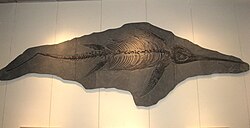| Eurhinosaurus Temporal range: Toarcian
~ | |
|---|---|

| |
| A 6.4 m (21 ft) Eurhinosaurus specimen | |
| Scientific classification | |
| Domain: | Eukaryota |
| Kingdom: | Animalia |
| Phylum: | Chordata |
| Class: | Reptilia |
| Order: | †Ichthyosauria |
| Family: | †Leptonectidae |
| Genus: | †Eurhinosaurus Abel, 1909 |
| Species | |
| |
Eurhinosaurus (Greek for 'well-nosed lizard'- eu meaning 'well or good', rhino meaning 'nose' and sauros meaning 'lizard') is an extinct genus of ichthyosaur from the Early Jurassic (Toarcian), ranging between 183 and 175 million years. Fossils of the aquatic reptile have been found in Western Europe (England, southern and northern Germany,[citation needed] the Benelux,[citation needed] France and Switzerland).[1][2][3][4] They used to live in the deep, open sea area.[5] Eurhinosaurus was a large genus of ichthyosaurs. An adult individual could reach up to 7 metres (23 ft) in length.[6]
Eurhinosaurus followed the regular body morphology, with a fish-like fusiform body including well developed dorsal fin, hypocercal caudal fin,[7] paired pectoral and pelvic fins, and remarkably large eyes.[3] Like other ichthyosaurs, Eurhinosaurus did not have gills and used lungs for breathing.[5] Eurhinosaurus had one distinct feature different from other ichthyosaurs: the upper jaw was twice as long as the lower jaw and covered with up and downwards-pointing teeth.[5][8]
- ^ Maisch MW. 2010: Phylogeny, systematics, and origin of the Ichthyosauria – the state of the art. Palaeodiversity 3: 151-214
- ^ Fischer V, Guiomar M & Godefroit P. 2011: New data on the palaeobiogeography of Early Jurassic marine reptiles: the Toarcian ichthyosaur fauna of the Vocontian Basin (SE France). Neues Jahrbuch für Geologie und Paläontologie, Abhandlungen 261(1): 111-127
- ^ a b Maisch MW, Matzke AT. 2000. The Ichthyosauria. Stuttgarter Beiträge zur Naturkunde, Serie B (Geologie und Paläontologie) 298: 1-159
- ^ Reisdorf AG, Maisch MW & Wetzel A. 2011. First record of the leptonectid ichthyosaur Eurhinosaurus longirostris from the Early Jurassic of Switzerland and its stratigraphic framework. Swiss Journal of Geosciences 104(2): 211-224
- ^ a b c Motani R. 2000. “Rulers of the Jurassic seas”. Scientific American. 283 (6): 52-59
- ^ Cheng Ji; Da-Yong Jiang; Ryosuke Motani; Olivier Rieppel; Wei-Cheng Hao; Zuo-Yu Sun (2016). "Phylogeny of the Ichthyopterygia incorporating recent discoveries from South China". Journal of Vertebrate Paleontology. 36 (1). e1025956. doi:10.1080/02724634.2015.1025956.
- ^ Crofts S. B., Shehata R. and Flammang B. E. 2019. Flexibility of Heterocercal Tails: What Can the Functional Morphology of Shark Tails Tell Us about Ichthyosaur Swimming?. Integrative Organismal Biology 1(1): obz002 1-10
- ^ McGowan. 1986. A Putative Ancestor For The Swordfish-like Ichthyosaur Eurhinosaurus. Nature. 322(31): 454-456